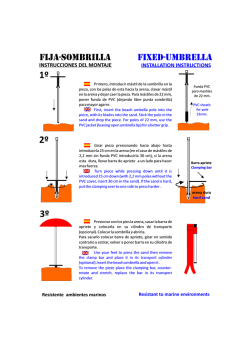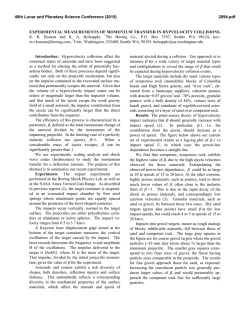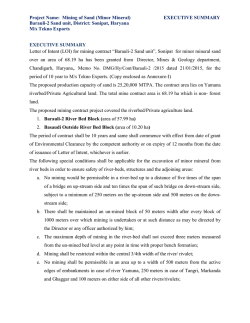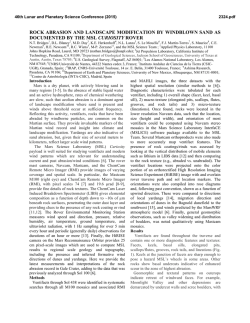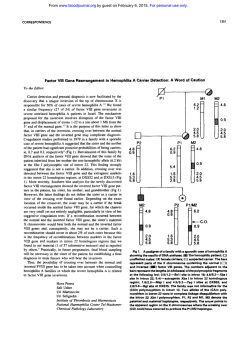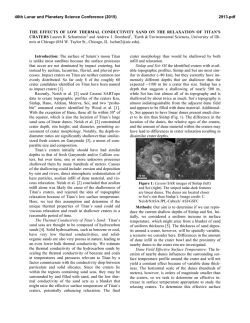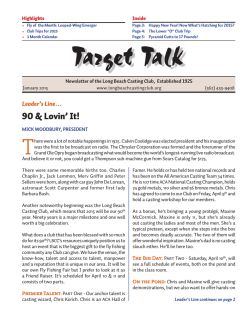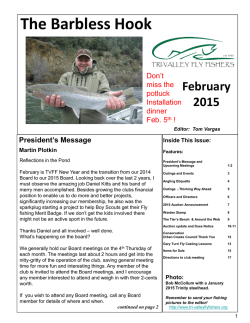
PDF (569 kB)
TREPAR-1349; No. of Pages 9 Review The past, present, and future of Leishmania genomics and transcriptomics Cinzia Cantacessi1, Filipe Dantas-Torres2,3, Matthew J. Nolan4, and Domenico Otranto3 1 Department of Veterinary Medicine, University of Cambridge, Cambridge, UK Departamento de Imunologia, Centro de Pesquisas Aggeu Magalha˜es, Fiocruz-PE, Brazil 3 Dipartimento di Medicina Veterinaria, Universita` degli Studi di Bari, Bari, Italy 4 Royal Veterinary College, University of London, North Mymms, UK 2 It has been nearly 10 years since the completion of the first entire genome sequence of a Leishmania parasite. Genomic and transcriptomic analyses have advanced our understanding of the biology of Leishmania, and shed new light on the complex interactions occurring within the parasite–host–vector triangle. Here, we review these advances and examine potential avenues for translation of these discoveries into treatment and control programs. In addition, we argue for a strong need to explore how disease in dogs relates to that in humans, and how an improved understanding in line with the ‘One Health’ concept may open new avenues for the control of these devastating diseases. Burden of leishmaniasis and the need for a ‘One Health’ initiative Leishmaniases are a group of diseases caused by digenetic protozoa of the genus Leishmania, which are transmitted by phlebotominae sand flies (Table 1). Based on recent estimates, up to 0.4 million and 1.2 million cases of visceral (VL) and cutaneous leishmaniasis (CL), respectively, occur each year in 98 countries and three territories where these diseases are endemic [1]. Despite their widespread distribution, over 90% of global VL cases occur in only six countries (India, Bangladesh, Sudan, South Sudan, Ethiopia, and Brazil), while most cases (70–75%) of CL occur in ten countries (Afghanistan, Algeria, Colombia, Brazil, Iran, Syria, Ethiopia, North Sudan, Costa Rica, and Peru) [1]. In most cases, leishmaniases are zoonoses, affecting the poor in rural and natural areas, where a plethora of domestic and wild reservoir hosts and sand fly vectors maintain the infection [2]. For instance, 13 out of the 21 human-infective Leishmania have also been reported in domestic dogs, the latter having a major role in maintaining and transmitting the infection to other receptive Corresponding author: Cantacessi, C. ([email protected]). Keywords: leishmaniases; Leishmania infantum; high-throughput sequencing; genome; transcriptome; bioinformatics; sand fly; metazoonosis; host-parasite interactions; One Health. 1471-4922/ ß 2015 Elsevier Ltd. This is an open access article under the CC BY license (http:// creativecommons.org/licenses/by/4.0/). http://dx.doi.org/10.1016/j.pt.2014.12.012 hosts via the sand fly vectors [3] (Table 1). In accordance with the concept of ‘One Health’, defined as ‘a movement to forge co-equal, all inclusive collaborations between physicians, [. . .], veterinarians and other scientific-health and environmentally related disciplines [. . .] to improve and defend the health and well-being of all species’ (http:// www.onehealthinitiative.com), successful control strategies against human leishmaniases must include preventative measures focussed on the human and animal hosts and arthropod vectors, as well as on the environments where the latter perpetuate [3]. To achieve these goals, a thorough understanding of the host–pathogen–vector triangle, and particularly of their intimate interactions at the molecular level, is imperative. Recent advances in -omics technologies, including genomics and transcriptomics, together with the considerable decrease in the cost of these techniques, provide exciting opportunities to reveal details of the intimate relations between Leishmania parasites, human and animal hosts, and sand fly vectors. In this review, we provide an overview of a range of milestone studies that have used genomics and transcriptomics techniques to improve current understanding of the biology of Leishmania, as well as of the molecular interactions between this parasite and its vertebrate and arthropod hosts. In addition, given the intimate relations between human and canine leishmaniases in endemic areas, and in line with the ‘One Health’ movement, we argue that current and future efforts should be directed towards integrating -omics technologies (i.e., genomics, transcriptomics, proteomics, metabolomics, and interactomics) to achieve a better understanding of the similarities and differences between human and canine infections, with the ultimate aim of developing new diagnostics, and treatment and control strategies against this devastating group of diseases. The fight against leishmaniasis: how can -omics help? The control of leishmaniases generally relies on the early diagnosis and treatment of human cases, vector control, and, in some cases, management of reservoir hosts (i.e., treatment and/or elimination) [3]. However, the control of leishmaniases, as with any vector-borne disease, is not trivial due to challenges relating to intervention programs, Trends in Parasitology xx (2015) 1–9 1 TREPAR-1349; No. of Pages 9 Review Trends in Parasitology xxx xxxx, Vol. xxx, No. x Table 1. Principal causative agents of human leishmaniases Leishmania species Leishmania aethiopica Leishmania amazonensis Principal tropism a C C Leishmania archibaldi d Leishmania braziliensis V C, MC Leishmania colombiensis Leishmania donovani C V Leishmania garnhami d Leishmania guyanensis C C Leishmania infantum V, C Leishmania Leishmania Leishmania Leishmania killicki d lainsoni lindenbergi major C C C C Leishmania mexicana C Leishmania naiffi Leishmania panamensis C C, MC Leishmania Leishmania Leishmania Leishmania C C C C peruviana pifanoi d shawi tropica Leishmania venezuelensis C Geographical distribution b Notes on the infection in dogs c Old World: Ethiopia, Kenya New World: Argentina, Bolivia, Brazil, Colombia, Ecuador, French Guiana, Peru, Suriname, Venezuela Old World: Ethiopia, Kenya, Lebanon, Sudan New World: Argentina, Belize, Bolivia, Brazil, Colombia, Costa Rica, Ecuador, Guatemala, French Guiana, Honduras, Mexico, Nicaragua, Panama, Paraguay, Peru, Venezuela New World: Colombia, Panama, Venezuela Old World: Bangladesh, Bhutan, China, Cyprus, Djibouti, Ethiopia, India, Iraq, Israel, Kenya, Nepal, Saudi Arabia, Somalia, Sri Lanka, Sudan, Ukraine, Uganda, Yemen New World: Costa Rica, Venezuela New World: Argentina, Bolivia, Brazil, Colombia, Ecuador, French Guiana, Guyana, Peru, Suriname, Venezuela Old World: Afghanistan, Albania, Algeria, Armenia, Azerbaijan, Bosnia and Herzegovina, Bulgaria, Central African Republic, China, Cyprus, Croatia, Egypt, France, Gambia, Georgia, Greece, Iraq, Iran, Israel, Italy, Libyan Arab Jamahiriya, Jordan, Kazakhstan, Kirgizstan, Lebanon, Macedonia, Malta, Morocco, Mauritania, Monaco, Montenegro, Oman, Pakistan, Palestine, Portugal, Syria, Romania, Senegal, Saudi Arabia, Slovenia, Spain, Sudan, Tunisia, Turkmenistan, Turkey, Ukraine, Uzbekistan, Yemen. NEW WORLD: Argentina, Bolivia, Brazil, Colombia, Costa Rica, El Salvador, Guatemala, Honduras, Mexico, Nicaragua, Paraguay, Venezuela Old World: Algeria, Libyan Arab Jamahiriya, Tunisia New World: Bolivia, Brazil, French Guiana, Peru, Suriname New World: Brazil Old World: Afghanistan, Algeria, Azerbaijan, Burkina Faso, Cameron, Chad, Egypt, Ethiopia, Georgia, Ghana, Guinea, Guinea-Bissau, India, Iraq, Israel, Libyan Arab Jamahiriya, Jordan, Kazakhstan, Kenya, Kuwait, Mali, Morocco, Mauritania, Mongolia, Niger, Nigeria, Oman, Pakistan, Palestine, Saudi Arabia, Syria, Iran, Senegal, Sudan, Tunisia, Turkmenistan, Uzbekistan, Yemen New World: Belize, Colombia, Costa Rica, Ecuador, Guatemala, Mexico, United States New World: Brazil, French Guiana, New World: Colombia, Costa Rica, Ecuador, Guatemala, Honduras, Nicaragua, Panama New World: Peru New World: Venezuela New World: Brazil Old World: Afghanistan, Azerbaijan, Egypt, Ethiopia, Greece, India, Iraq, Israel, Iran, Jordan, Kenya, Morocco, Namibia, Pakistan, Palestine, Saudi Arabia, Syria, Turkmenistan, Turkey, Uzbekistan, Yemen New World: Venezuela VL cases in Brazil VL cases in Sudan CL cases in Argentina, Bolivia, Brazil Colombia, Peru, and Venezuela VL in a dog in Venezuela Dogs are commonly infected in some countries (e.g., Sudan), but their role as reservoirs is unknown CL cases in Colombia VL cases usually found in areas where human cases are reported. Autochthonous cases reported in dogs in the USA (no human cases reported so far) CL in Egypt and Saudi Arabia CL in Ecuador and USA CL in Ecuador and Colombia CL in Peru CL in Ecuador CL cases in India, Iran, Israel, Morocco, and Syria a Abbreviations: C, dermotropic; MC, mucotropic; V, viscerotropic. b Based on [63,64]. c Based on [54,65,66]. In addition, Leishmania arabica has been reported in dogs in Saudi Arabia [67]. Moreover, other Leishmania species (e.g., Leishmania equatorensis and Leishmania utingensis) [68,69] have been described from wildlife and/or sand flies, but have not yet been detected in humans or dogs. d Species status is under discussion [63,70]. mostly in developing countries, where the burden of disease is heavier (due to a combination of factors including, but not limited to, a lack of political will, of human resources, and of infrastructure). In addition, our limited knowledge of the host–pathogen–vector triangle, particularly of their intimate interactions at the molecular level, impairs the development of more affordable and effective control tools, such as antivector vaccines and more effective chemotherapeutics. 2 -Omics technologies are increasingly being applied to investigations of determinants of disease phenotype [4], mode of action of current drugs [5], and parasite biology [6]. These studies have improved our understanding of the pathogenesis of disease in humans and possible mechanisms of resistance to antileishmanial drugs. Without a doubt, -omics approaches are likely to reveal details of the intimate relations between hosts, parasites, and vectors. This refined knowledge will foster the development of new TREPAR-1349; No. of Pages 9 Review control tools (e.g., antivector vaccines) that could assist the fight against leishmaniases. The determination of the whole genome sequences of a range of Leishmania parasites causing both VL and CL represents the first step towards these goals, providing the scientific community with a solid infrastructure for postgenomic investigations of the parasite biology, pathogenicity, and mastery mechanisms of manipulation of both insect and vertebrate hosts. The Leishmania genomes: a ‘toolbox’ to understand host–parasite interactions Efforts to determine the whole genome sequence of key Leishmania species infecting humans were consolidated in 1994 in Rio de Janeiro (Brazil), with the establishment of the Leishmania Genome Network (LGN) initiative. Not only did this network represent the researchers’ first move to expand existing knowledge of the fundamental molecular biology of this parasite, with a view towards promoting the discovery of novel treatment and control strategies, but it also saw the support of the FIOCRUZ and UNICEF/ UNDP/World Bank/WHO Special Programme for Research and Training in Tropical Diseases [7]. In 2005, these efforts proved successful, with the publication of the first complete genome sequence of Leishmania major (causing CL) [8], soon followed by those of Leishmania infantum (causing VL) and Leishmania braziliensis (causing mucocutaneous leishmaniasis; MCL) [9]. In recent years, the advent of high-throughput sequencing technologies (Box 1) has assisted relentless progress in the genomics of human leishmaniases, with the completion of the whole genome sequences of Leishmania mexicana (CL; [10]), Leishmania donovani (VL; [11]) and Leishmania amazonensis (CL; [12]) (Box 1). The availability of these genome sequences has provided unprecedented opportunities to perform detailed comparative analyses of Leishmania species associated with different human diseases at a scale previously unimaginable [9,12]. The genomes of Leishmania vary from 29 Mb (L. amazonensis; [12]) to 33 Mb in size (L. major, L. infantum and L. braziliensis; [9]) and are organised into a variable number of chromosomes (i.e., 34 in L. amazonensis and Trends in Parasitology xxx xxxx, Vol. xxx, No. x L. mexicana, 35 in L. brasiliensis, and 36 in L. major, L. donovani, and L. infantum) [12]. Despite the striking variability in pathogenicity and tissue tropism of different Leishmania species, their genomes are remarkably similar, displaying a high degree of conservation in gene content and architecture (synteny) [9,12]. The genomes of Leishmania spp. are characterised by a high gene density, the presence of long arrays of polycistronic gene clusters, and the almost complete absence of introns [7]. However, careful examination of protein-coding genes in Leishmania allowed the identification of a relatively small number of species-specific genes, the majority of which encode predicted proteins of unknown function [10]. Only a few of these genes could be associated to specific tissue tropism. For instance, LinJ.28.0340, a gene specific to L. infantum and occurring as a pseudogene in L. major, L. braziliensis, and L. mexicana [10], has been implicated in the ability of the latter to spread and survive in visceral organs of the vertebrate hosts [13]. Indeed, when a L. donovani gene orthologue of LinJ.28.0340 was introduced into transgenic L. major, the latter displayed a significantly increased capacity to survive in visceral organs of BALB/C mice [13]. Conversely, the spleens and livers of mice infected with the LinJ.28.0340/L. donovani null mutant were characterised by significantly reduced parasite burdens compared with those infected with the wild type L. donovani counterpart, thus providing solid evidence for a role of this gene in the visceralisation of the infection [13]. Among other genes thought to have key roles in the ability of species within the L. donovani complex to colonize visceral organs, those belonging to the A2 gene family are also present as pseudogenes in L. major [14]. These genes were first identified in L. donovani and shown to be exclusively expressed by the amastigote stage (cf. [14]) (Figure 1); subsequently, these genes were demonstrated to be essential for the survival of L. donovani in visceral organs, while transgenic L. major expressing A2 genes displayed increased survival in the spleens of infected mice [14]. Despite the evidence for a role of A2 genes in the pathogenesis of VL, molecules encoding A2 proteins have also been identified in Leishmania species responsible for CL, such Box 1. DNA sequencing technologies and Leishmania genomics: a decade of progress In 2005, the Leishmania major genome was published in the journal Science [8]. The successful completion of the first whole genome sequence of a Leishmania species resulted from a collaboration between the Wellcome Trust Sanger Institute (UK), the WTSIcoordinated EULEISH consortium, and the Seattle Biomedical Research Institute (USA) [8]. The sequencing strategy utilised a combination of high- and low-coverage large insert clone sequencing and a whole chromosome shotgun approach, preceded by purification of single or co-migrating chromosomes using pulse-field gel electrophoresis (PFGE) [8]. In 2007, the genomes of two additional Leishmania species, those of Leishmania infantum and Leishmania braziliensis, were completed by a multi-institutional network of scientists led by the WTSI [9]; to generate an approximate sixfold coverage of the complete genome sequences of these two species, researchers utilised whole-genome shotgun sequencing of plasmid clones containing genome fragments of variable length (up to 4 kb). Four years later, a similar approach was used to sequence the genome of Leishmania mexicana [10]. In the same year, the reference genome of Leishmania donovani was the first to be completed using a next-generation sequencing strategy [11]; in particular, using a pyrosequencing approach (454 Roche), Downing and colleagues generated a total of 1.29 million single-end and 3.58 million pairedend reads [with an average length of 167 base pairs (bp)], 96% of which were assembled into an initial set of reference contigs and scaffolds [11]; subsequently, 17 clinical isolates of L. donovani obtained from Nepalese and Indian patients with VL (including the isolate from which the reference genome sequence was obtained), were sequenced using high-throughput Illumina sequencing, generating a total of 41 Gb of sequence data [11]. Then, the 76-bp pairedend reads from each isolate were mapped to the reference genome sequence for SNP analysis, which resulted in new insights into Leishmania population genetics and mechanisms of emerging drug resistance [11]. The most recent Leishmania genome sequence (i.e., that of Leishmania amazonensis [12]) was generated using a combination of 454 and Illumina sequencing. The approximately 179 000 454 reads corresponded to a twofold coverage of the L. amazonensis genome and were assembled into 27 856 contigs that, together with the 4411 scaffolds derived from the assembly of approximately 37 million 76-bp paired-end Illumina reads, resulted in the final assembly of 2627 scaffolds [12]. 3 TREPAR-1349; No. of Pages 9 Review Trends in Parasitology xxx xxxx, Vol. xxx, No. x Amasgotes of viscerotropic Leishmania express A2 genes, implicated in visceralisaon of infecon [15] 3 2 4 Mammalian host 1 5 Simultaneously, Cox2 genes overexpressed by infected macrophages promote parasite survival [25] 6 Peritrophins and chins expressed by the sand fly midgut serve as a barrier to the migraon of Leishmania to the thoracic midgut, unl their degradaon by proteolyc enzymes [36] 7 Sand fly Salivary components, such as maxadilan and hyaluronidases, exacerbate parasite infecvity and promote the infecon process [71] 8 9 TRENDS in Parasitology Figure 1. Life cycle of Leishmania spp. and examples of molecules putatively involved in parasite infectivity and visceralisation of infection. Phlebotominae sand flies release Leishmania infective stages (i.e., metacyclic promastigotes) to the mammalian hosts during blood feeding (1); the parasites invade macrophages and granulocytes (2 and 3) and develop to amastigotes inside the phagolysosome (4); the amastigote stages replicate within the phagolysosome by simple division (5); then, amastigotecontaining macrophages are ingested by susceptible sand flies during the blood meal (6); the parasites are released from the infected macrophages within the sand fly midgut (7), where they transform into procyclic promastigotes and divide. Then, the parasites migrate towards the stomodeal valve (anterior midgut) and transform into different promastigote subtypes that ultimately form metacyclic promastigotes (8). These infective stages are then released into a new mammalian host during a subsequent blood meal (9) [15,25,36,71]. Abbreviation: Cox2, prostaglandin-endoperoxide synthase 2. as L. amazonensis and L. mexicana [10,12]. While the presence of these proteins in Leishmania parasites with skin tropism has been attributed to functional divergence between Old World and New World species [14], their role in the pathogenesis of CL is yet to be ascertained. Interestingly, a recent comparative analysis of the genomes and transcriptomes of two phenotypically distinct substrains of L. donovani (i.e., one causing VL and one responsible for a large number of cases of CL in Sri Lanka) revealed an increased copy number of A2 genes in L. donovani causing VL, which was also associated with significant upregulation in A2 mRNA transcription and protein expression in strains causing VL [15]. In the same study, Zhang and colleagues [15] identified the presence of several nonsynonymous SNPs in genes from the L. donovani CL strain. Among these was a molecule encoding a ras-like small GTPase-RagC protein; insertion of the corresponding orthologous gene from the L. donovani VL isolate into the CL counterpart resulted in a significant increase in parasite burdens in the spleen of infected mice 4 [15]. These data provided evidence of the impact of SNPs on gene function and phenotype, thus refining current understanding of their potential impact on the pathogenicity of different strains of Leishmania. While comparative analyses of the whole genome sequences of Leishmania species causing CL and VL represent a solid basis for in-depth investigations of the intimate mechanisms of host–parasite interactions that result in different courses of infection, studies of the regulation of parasite gene expression throughout its life cycle in both the vertebrate hosts and the sand fly vectors are likely to contribute to a better understanding of the pathogenesis of disease. Clearly, the availability of an array of genomes, together with an explosion in microarray and highthroughput transcriptomic sequencing technologies, have facilitated such studies (e.g., [16–19]). However, the same organisation into polycistronic transcription units that makes the genomes of CL- and VL-causing Leishmania so strikingly similar [7] has been deemed responsible for the lack of extensive gene expression regulation at the TREPAR-1349; No. of Pages 9 Review transcriptional level [20]. Indeed, most Leishmania genes have been shown to be constitutively expressed throughout the transition from promastigote to amastigote stage [21], with post-transcriptional events, including mechanisms that control the abundance of mRNAs, translation rates and post-translational protein stability, hypothesised to have key roles in the regulation of protein abundance [21]. However, the marked variation in chromosome and gene copy numbers among strains of L. infantum, L. mexicana, L. braziliensis, and L. major unveiled, for the first time, a degree of aneuploidy in the genomes of these parasites [10]. Accordingly, unstable ploidy among strains of L. infantum, as well as variable chromosomal contents among cells, revealed that the Leishmania genome is characterised by ‘mosaic aneuploidy’ [11,22]. Therefore, ‘genome plasticity’ and ‘gene dosage’, rather than differential expression of single genes and gene products, are increasingly being considered as two of the keys to the different tissue tropism of Leishmania spp. [22]. Transcriptomics unveils Leishmania-mediated regulation of host gene expression Several transcriptomic studies have investigated Leishmania-induced regulation of gene expression in infected tissues with the aim to link such responses to disease outcome. As an example, for VL-causing Leishmania, Beattie and colleagues [23] used whole-genome array technologies to compare the gene expression profiles of liverresident macrophages (Kupffer cells) from mice infected by L. donovani to those of uninfected macrophages exposed to inflammatory stimuli. The authors showed significant upregulation of genes within the retinoid X receptor a pathway (i.e., Rxra), linked to lipid metabolism, in uninfected macrophages exposed to inflammation compared with the infected counterpart [23]; pharmacological perturbation of the activity of this pathway in Kupffer cells resulted in an increased resistance of these cells to Leishmania infection, which led to speculation that either this pathway has a role in the usage of lipids and cholesterol by the parasite, or that Leishmania lipids regulate the activation of innate immune responses that follow the infection [23]. For CL-causing Leishmania, Maretti-Mira and colleagues [24] utilised high-throughput RNA-Seq technologies to characterise and compare the transcriptomes of tissue fragments obtained from human subjects with CL and MCL caused by L. braziliensis [24]. The outcomes from this study highlighted significant upregulation of genes involved in biological pathways linked to the recruitment and activation of immune cells (including lymphocytes, granulocytes, natural killer cells, and antigen-presenting cells) and to regulation of inflammatory responses in tissues from subjects with CL [24]. This suggested that the inability of the host to mount effective immune responses against the parasite at the site of cutaneous infection is linked to the progression of disease [24]. In an effort to characterise differences in macrophage gene expression that might contribute to the ability of different Leishmania spp. to cause localised (CL) or systemic infections (VL), Gregory and colleagues [25] used a DNA microarray approach to perform comparative analyses of the transcriptomes of murine macrophages infected Trends in Parasitology xxx xxxx, Vol. xxx, No. x by L. major and L. donovani. Interestingly, both parasites induced a similar differential regulation of relatively small numbers of macrophage genes, with most of these genes unsurprisingly linked to the development of immune responses [25]. The only noticeable difference in gene expression profiling between L. major- and L. donovani-infected macrophages was a remarkable increase in levels of transcription of mRNAs encoding prostaglandinendoperoxide synthase (Cox2) in the latter, which led to speculation that this pathway is involved in the pathogenesis of VL [25] (Figure 1). Clearly, the availability of high-throughput transcriptomic technologies has resulted in rapid expansion of the already substantial plethora of knowledge of the molecular interactions occurring between Leishmania and the human host; nevertheless, significant variation in host responses to infection has been described in several studies (cf. [26]), although a review of this variation is beyond the scope of the present article. However, these technologies have also enabled progress towards the exploration of the molecular relationships between the parasite and the sand fly vector and the patterns of Leishmania development into its infective, nondividing metacyclic form [27]. Transcriptomics in Leishmania–sand fly interactions Transmission of Leishmania from an infected to a susceptible host requires development of the parasites in the midgut of a competent sand fly vector. Macrophages containing Leishmania amastigotes are ingested by sand fly vectors via a blood meal and, once released in the insect midgut, develop through several developmental stages into infective, metacyclic promastigotes [26] (Figure 1). The reproductive mode of Leishmania parasites has traditionally been considered clonal, based on strong linkage disequilibrium (cf. [28]); however, several studies have provided solid evidence of the occurrence of genetic exchange between species and/or strains of Leishmania (i.e., L. major and L. infantum) during growth and development in the sand fly vector, with successful transmission of the hybrid progeny to a susceptible vertebrate host [28–32]. The range of vertebrate and invertebrate host species that Leishmania can infect, as well as the multiple forms of disease that it causes, have been partly attributed to the ability of this parasite to undergo genetic exchange in the sand fly vector (cf. [29]). Clearly, the molecular interactions that occur at the parasite–sand fly interface are key processes that determine the successful development and transmission of Leishmania; therefore, a detailed understanding of these mechanisms has become a priority. Previous studies had used Sanger sequencing of cDNA libraries from the midgut of sand fly vectors of both CL- and VL-causing Leishmania (i.e., Phlebotomus papatasi, vector of L. major and Lutzomyia longipalpis, vector of L. infantum; [33,34]) to identify molecules putatively involved in the development of the parasites in their insect vectors. While sand fly infections by L. major and L. infantum were consistently associated with downregulation of molecules encoding microvilli-like proteins and chymotrypsin and upregulation of trypsin-encoding transcripts, the transcription profiles of peritrophinlike molecules were inconsistent between P. papatasi 5 TREPAR-1349; No. of Pages 9 Review and Lu. longipalpis [33,34]. Peritrophins are the protein component of the peritrophic matrix (PM), an extracellular chitin-containing structure that encapsulates the blood meal following its ingestion by the sand fly [35]. The formation of the PM (immediately following the blood meal) has long been considered advantageous for Leishmania, because the parasites are thought to be protected from the action of the sand fly proteolytic enzymes during the vulnerable time of development to promastigotes [35]. Several key investigations have contributed to further understanding of the relations between Leishmania promastigotes and the sand fly PM (e.g., [36]). In particular, while previous studies hypothesised a role of Leishmania chitinases in the disintegration of the sand fly PM (cf. [36]), current evidence supports the theory that the breakdown of the PM is independent from the activity of Leishmania enzymes and that parasite promastigotes escape the PM by migrating through a posterior opening that forms irrespective of the infection status of the sand fly [36]. In the same study, Sadlova and Volf [36] showed that the anterior plug of the PM serves as a ‘barrier’ for parasite migration to the thoracic midgut, until its degradation from sand fly proteolytic enzymes is complete [36]. The elucidation of patterns of sand fly gene expression during the disintegration of the PM in the presence (or not) of Leishmania parasites, and during migration of the latter from the abdominal to the thoracic midgut, may help to either confirm or confute this point. Together with studies of the midgut of sand flies, other investigations used transcriptomic technologies to shed light on the molecular mechanisms that govern the development of Leishmania parasites into their infective metacyclic stage [37]. While little information is available on sand fly molecular pathways acting as trigger of Leishmania metacyclogenesis, recent studies highlighted the role of key genes and gene products in the differentiation of promastigote stages into metacyclic forms in the sand fly vector. Among these molecules, a hydrophilic acylated surface protein (HASPB) and a small hydrophilic endoplasmic reticulum (ER)-associated protein (SHERP) showed increased expression in the metacyclic stages [38]; in addition, creation of HASPB and SHERP null mutants in L. major resulted in the accumulation of non-infective parasite stages in the midgut of the sand fly vector, thus providing evidence for the essentiality of these molecules for parasite development [38]. Investigations of patterns of gene transcription during Leishmania metacyclogenesis in vitro have led to the identification of genes and gene products potentially related to parasite infectivity (e.g. [37,39–41]). For instance, recent functional studies of essential molecules in L. major metacyclic promastigotes highlighted major roles of mitogen-activated protein kinases (i.e., MAPK4) and metallopeptidases of the M24A family in the establishment of intracellular macrophage infections [40] and proliferation in infected cells [41]. These data provided a solid basis for the exploration of the role of these molecules as novel targets for intervention strategies. In recent years, the search for new and effective preventative measures against Leishmania transmission has 6 Trends in Parasitology xxx xxxx, Vol. xxx, No. x Box 2. Sand-fly salivary gland secreted proteins and Leishmania: examples from a successful partnership The salivary glands of sand fly vectors secrete several proteins known to facilitate the process of host invasion by Leishmania [27]. Among these proteins, maxadilan, a known vasodilator, was first described in Lutzomyia longipalpis and shown to exacerbate the infectivity of Leishmania major via the inhibition of lymphocyte proliferation [47]. Since this first report, a range of other molecules has been described from the salivary glands of an array of sand fly species that contribute to the successful establishment of Leishmania infections. Among these molecules, protein homologues of salivary hyaluronidases secreted by Phlebotomus papatasi were demonstrated to have a role in the severity of skin lesions caused by L. major [71]. While the mechanisms that result into this outcome are yet to be elucidated, Volfova and colleagues [71] hypothesised that the neutrophils recruited through the enzymatic activity of sand fly hyaluronidases (via the presence of hyaluronan fragments) may be exploited by Leishmania as ‘Trojan horses’, thus facilitating macrophage infection [71]. Interestingly, a secreted endonuclease identified from the sialotranscriptome of Lu. longipalpis has been recently implicated in the ability of Leishmania to evade killing by neutrophils [47]. This protein was shown to interfere with the microbicidal activity of neutrophils recruited at the site of a sand fly bite by disintegrating the neutrophil extracellular traps (NETs) that ensnare Leishmania parasites, thus significantly contributing to the immunoevasive strategies of the parasite and enhancing its infectivity [47]. also involved the characterisation of key components of the saliva of the sand fly vectors (e.g., [27,42–46]). The interest of the scientific community in salivary gland transcriptomes (‘sialotranscriptomes’) is mainly derived from knowledge that selected saliva proteins have crucial roles in facilitating the successful establishment of Leishmania parasites in vertebrate hosts, including the regulation of the immune response at the site of bite [27,46,47]. Therefore, sialotranscriptomes of several competent sand fly vector species are now available (e.g., [43–45,48–51]), which, in some cases, have led to the selection of key sand fly molecules that are involved in the blood-feeding process and that may assist the immunoevasive strategies of Leishmania [47,52] (Box 2). For instance, a potent vasodilator (maxadilan) abundantly detected in the saliva of Lu. longipalpis [53] has not been identified in transcriptomic data sets from the salivary glands of Lutzomyia ayacuchensis [44]. Similarly, a maxadilan homologue identified in Lutzomyia intermedia showed only 34% identity to maxadilan from Lu. longipalpis [50]. It is worth noting that both Lu. intermedia and Lu. ayacuchensis are vectors of dermotropic Leishmania species, whereas Lu. longipalpis, whose saliva contains large amounts of maxadilan, is the main vector of the viscerotropic L. infantum in the New World [54] (Figure 1). While these observations suggested a role of maxadilan in visceralisation of L. infantum infection [55], the absence of maxadilan homologues from the saliva of sand fly vectors of VL in the Old World raises questions about the role/s of other salivary components in disease progression. Indeed, other enzymes, such as hyaluronidases and apyrases, have been identified using transcriptomic and proteomic technologies from several sand fly vectors of VL in both the Old and New Worlds [45]. These enzymes have been shown to positively contribute to the spread of Leishmania parasites by promoting TREPAR-1349; No. of Pages 9 Review the enlargement of the feeding lesion and the diffusion of other salivary active compounds (hyaluronidases) and preventing haemostasis (apyrases) [45]. Besides containing components essential to the infection process, the saliva of sand flies contains molecules that can elicit specific immune responses that are indicative of host exposure to sand fly bites (e.g., [56,57]). In particular, three proteins from the saliva of P. perniciosus (i.e., two yellow proteins and an apyrase), expressed in recombinant form, were shown to be useful in determining the intensity of exposure to sand fly bites in experimentally bitten mice and dogs [57]. While cross-reactivity between anti-P. perniciosus antibodies and those from closely related sand fly species was not assessed [57], the authors hypothesised that this may occur. Both yellow proteins and apyrases have been detected in the saliva of a range of sand fly species. However, subtle differences in sequence may result in varying immunogenic properties; future investigations using transcriptomic and proteomic technologies may assist elucidating this point via, for instance, the generation of whole transcript and/or protein data sets from sand fly vector species, with the ultimate aim of identifying suitable targets for the development of commercial diagnostic tools to assess the risk of human and canine transmission in both endemic and nonendemic areas, and the evaluation of the effectiveness of antivector campaigns [56]; this improved knowledge could also aid current efforts aimed at developing recombinant vaccines containing immunogenic components from both the parasite and the sand fly vectors. In addition, thus far, no data are available on the effects of Leishmania infections on the global transcriptional profiles of sand fly vectors. Future studies could, for instance, utilise RNA-Seq technologies to investigate differences in gene expression profiling of Leishmania-infected and uninfected sand flies. Exploring and identifying molecular pathways involved in the parasite–vector–host interactions may lead to the identification of new molecular pathways implicated in the infection process, which would be instrumental for refining current control strategies against sand flies. Undoubtedly, some challenges exist in performing large-scale transcriptomic studies of species for which a reference genome is unavailable; among these challenges, the de novo assembly of fulllength transcripts in absence of reference sequences is one of the most significant [58]. Nevertheless, other resources, such as the genomes and transcriptomes of selected mosquito species [59] that are phylogenetically related to sand fly vectors of Leishmania [60], could be exploited for the accurate reconstruction of (at least) a proportion of fulllength sand fly transcripts, thus reducing overall project costs and limiting potential biases introduced by de novo assembly. Concluding remarks and research needs Over the past decade, advances in genomics and transcriptomics technologies have contributed to considerably enhance our knowledge of the set of molecular interactions that occur within the host–parasite–vector triangle. However, some gaps still exist in our understanding of the similarities and/or differences between human leishmaniases and the disease in animal reservoir hosts. Dogs, for Trends in Parasitology xxx xxxx, Vol. xxx, No. x instance, represent the most important host reservoir for L. infantum (causing VL) [3,61]. Therefore, differences and similarities between human and canine infections should be comprehensively analysed. However, most studies of Leishmania immunobiology and genetics, as well as of host–parasite interactions, utilise murine models of infection as ‘mirrors’ of human disease [61]. Given that transmission of key Leishmania species (e.g., L. infantum) to humans strictly relies on the circulation of the parasite among canine populations, elucidating whether dog leishmaniasis serves as a model for human infections should become a priority. This could provide avenues for studies aimed, for instance, at evaluating the ‘translatability’ of novel treatment and vaccine strategies from humans to dogs and vice versa. The availability of in vivo canine models of leishmaniasis [62], together with advances in genomics and/or transcriptomics, proteomics, and metabolomics technologies, may assist this quest. For instance, RNA-Seq and high-throughput proteomics platforms provide a golden opportunity to monitor changes in host gene transcription and protein expression throughout the course of canine and human infections, thus enabling one to draw parallels between them. Similarly, large-scale analyses of metabolites produced during the course of infection, both by the parasite and the vertebrate host, may represent a gold mine for the identification of novel diagnostic biomarkers, as well as of potential new Leishmania ‘Achilles’ heels’ that could assist current programs aimed at breaking the transmission cycle of human and canine leishmaniases. Acknowledgements Part of this article was conceived within the framework of of the EurNegVec COST Action TD1303. Funding from the Isaac Newton Trust/ Wellcome Trust ISSF/University of Cambridge Joint Research Grants Scheme to C.C. is gratefully acknowledged. References 1 Alvar, J. et al. (2012) Leishmaniasis worldwide and global estimates of its incidence. PLoS ONE 7, e35671 2 Ready, P.D. (2013) Biology of phlebotomine sand flies as vectors of disease agents. Annu. Rev. Entomol. 58, 227–250 3 Otranto, D. and Dantas-Torres, F. (2013) The prevention of canine leishmaniasis and its impact on public health. Trends Parasitol. 29, 339–345 4 McCall, L.I. and McKerrow, J.H. (2014) Determinants of disease phenotype in trypanosomatid parasites. Trends Parasitol. 30, 342–349 5 Kaur, G. and Rajput, B. (2014) Comparative analysis of the omics technologies used to study antimonial, amphotericin B, and pentamidine resistance in Leishmania. J. Parasitol. Res. 2014, 726328 6 Pawar, H. et al. (2014) Neglected tropical diseases and omics science: proteogenomics analysis of the promastigote stage of Leishmania major parasite. OMICS 18, 499–512 7 Uliana, S.R.B. et al. (2008) Leishmania genomics: where do we stand? In Bioinformatics in Tropical Disease Research: A Practical and CaseStudy Approach (Gruber, A. et al., eds), National Library of Medicine, National Center for Biotechnology Information Chapter B02 8 Ivens, A.C. et al. (2005) The genome of the kinetoplastid parasite, Leishmania major. Science 309, 436–442 9 Peacock, C.S. et al. (2007) Comparative genomic analysis of three Leishmania species that cause diverse human disease. Nat. Genet. 39, 839–847 10 Rogers, M.B. et al. (2011) Chromosome and gene copy number variation allow major structural change between species and strains of Leishmania. Genome Res. 21, 2129–2142 7 TREPAR-1349; No. of Pages 9 Review 11 Downing, T. et al. (2011) Whole genome sequencing of multiple Leishmania donovani clinical isolates provides insights into population structure and mechanisms of drug resistance. Genome Res. 21, 2143–2156 12 Real, F. et al. (2013) The genome sequence of Leishmania (Leishmania) amazonensis: functional annotation and extended analysis of gene models. DNA Res. 20, 567–581 13 Zhang, W.W. and Matlashewski, G. (2010) Screening Leishmania donovani-specific genes required for visceral infection. Mol. Microbiol. 77, 505–517 14 Zhang, W.W. et al. (2003) Comparison of the A2 gene locus in Leishmania donovani and Leishmania major and its control over cutaneous infection. J. Biol. Chem. 35508–35515 15 Zhang, W.W. et al. (2014) Genetic analysis of Leishmania donovani tropism using a naturally attenuated cutaneous strain. PLoS Pathog. 10, e1004244 16 Cohen-Freue, G. et al. (2007) Global gene expression in Leishmania. Int. J. Parasitol. 37, 1077–1086 17 Saxena, A. et al. (2007) Evaluation of differential gene expression in Leishmania major Friedlin procyclics and metacyclics using DNA microarray analysis. Mol. Biochem. Parasitol. 129, 103–114 18 Alcolea, P.J. et al. (2010) Transcriptomics throughout the life cycle of Leishmania infantum: high down-regulation rate in the amastigote stage. Int. J. Parasitol. 40, 1497–1516 19 Rastrojo, A. et al. (2013) The transcriptome of Leishmania major in the axenic promastigote stage: transcript annotation and relative expression levels by RNA-Seq. BMC Genomics 14, 223 20 Soysa, R. et al. (2014) A dual luciferase system for analysis of posttranscriptional regulation of gene expression in Leishmania. Mol. Biochem. Parasitol. 195, 1–5 21 Requena, J.M. (2011) Lights and shadows on gene organization and regulation of gene expression in Leishmania. Front. Biosci. 16, 2069– 2085 22 Sterkers, Y. et al. (2012) Novel insights into genome plasticity in Eukaryotes: mosaic aneuploidy in Leishmania. Mol. Microbiol. 86, 15–23 23 Beattie, L. et al. (2013) A transcriptomic network identified in uninfected macrophages responding to inflammation control intracellular pathogen survival. Cell Host Microbe 14, 357–368 24 Maretti-Mira, A.C. et al. (2012) Transcriptome patterns from primary cutaneous Leishmania braziliensis infections associated with eventual development of mucosal disease in humans. PLoS Negl. Trop. Dis. 6, e1816 25 Gregory, D.J. et al. (2008) Comparison of the effects of Leishmania major or Leishmania donovani infection on macrophage gene expression. Infect. Immun. 76, 1186–1192 26 Kima, P.E. (2014) Leishmania molecules that mediate intracellular pathogenesis. Microbes Infect. 16, 721–726 27 Oliveira, F. et al. (2009) Sand flies, Leishmania, and transcriptomeborne solutions. Parasitol. Int. 58, 1–5 28 Akopyants, N.S. et al. (2009) Demonstration of genetic exchange during cyclical development of Leishmania in the sand fly vector. Science 324, 265–268 29 Inbar, E. et al. (2013) The mating competence of geographically diverse Leishmania major strains in their natural and unnatural sand fly vectors. PLoS Genet. 9, e1003672 30 Calvo-Alvarez, E. et al. (2014) First evidence of intraclonal genetic exchange in trypanosomatids using two Leishmania infantum fluorescent transgenic clones. PLoS Negl. Trop. Dis. 8, e3075 31 Ravel, C. et al. (2006) First report of genetic hybrids between two very divergent Leishmania species: Leishmania infantum and Leishmania major. Int. J. Parasitol. 36, 1383–1388 32 Volf, P. et al. (2007) Increased transmission potential of Leishmania major/Leishmania infantum hybrids. Int. J. Parasitol. 37, 589–593 33 Ramalho-Ortigao, M. et al. (2007) Exploring the midgut transcriptome of Phlebotomus papatasi: comparative analysis of expression profiles of sugar-fed, blood-fed and Leishmania major-infected sandflies. BMC Genomics 8, 300 34 Jochim, R.C. et al. (2008) The midgut transcriptome of Lutzomyia longipalpis: comparative analysis of cDNA libraries from sugar-fed, blood-fed, post-digested and Leishmania infantum-chagasi–infected sand flies. BMC Genomics 9, 15 35 Pimenta, P.F. et al. (1997) A novel role for the peritrophic matrix in protecting Leishmania from the hydrolytic activities of the sand fly midgut. Parasitology 115, 359–369 8 Trends in Parasitology xxx xxxx, Vol. xxx, No. x 36 Sadlova, J. and Volf, P. (2009) Peritrophic matrix of Phlebotomus duboscqi and its kinetics during Leishmania major development. Cell Tissue Res. 337, 313–325 37 Dostalova, A. and Volf, P. (2012) Leishmania development in sand flies: parasites–vector interactions overview. Parasit. Vectors 5, 276 38 Sadlova, J. et al. (2010) The stage-regulated HASPB and SHERP proteins are essential for differentiation of the protozoan parasite Leishmania major in its sand fly vector, Phlebotomus papatasi. Cell Microbiol. 12, 1765–1779 39 Cunha, J. et al. (2013) Characterization of the biology and infectivity of Leishmania infantum viscerotropic and dermotropic strains isolated from HIV+ and HIV– patients in the murine model of visceral leishmaniasis. Parasit. Vectors 6, 122 40 Dacher, M. et al. (2014) Probing druggability and biological function of essential proteins in Leishmania combining facilitated null mutant and plasmid shuffle analyses. Mol. Microbiol. 93, 146–166 41 Norris-Mullins, B. et al. (2014) LmaPA2G4, a homolog of human Ebp1, is an essential gene and inhibits cell proliferation in L. major. PLoS Negl. Trop. Dis. 8, e2646 42 Dostalova, A. et al. (2011) The midgut transcriptome of Phlebotomus (Larroussius) perniciosus, a vector of Leishmania infantum: comparison of sugar fed and blood fed sand flies. BMC Genomics 12, 223 43 Rohousova, I. et al. (2012) Salivary gland transcriptomes and proteomes of Phlebotomus tobbi and Phlebotomus sergenti, vectors of leishmaniasis. PLoS Negl. Trop. Dis. 6, e1660 44 Kato, H. et al. (2013) Analysis of salivary gland transcripts of the sand fly Lutzomyia ayacuchensis, a vector of Andean-type cutaneous leishmaniasis. Infect. Genet. Evol. 13, 56–66 45 Vlkova, M. et al. (2014) Comparative analysis of salivary gland transcriptomes of Phlebotomus orientalis sand flies from endemic and non-endemic foci of visceral leishmaniosis. PLoS Negl. Trop. Dis. 8, e2709 46 Hostomska, J. et al. (2009) Analysis of salivary transcripts and antigens of the sand fly Phlebotomus arabicus. BMC Genomics 10, 282 47 Chagas, A.C. et al. (2014) Lundep, a sand fly salivary endonuclease increases Leishmania parasite survival in neutrophils and inhibits XIIa contact activation in human plasma. PLoS Pathog. 10, e1003923 48 Abdeladhim, M. et al. (2012) Updating the salivary gland transcriptome of Phlebotomus papatasi (Tunisian strain): the search for sand fly-secreted immunogenic proteins for humans. PLoS ONE 7, e47347 49 Abrudan, J. et al. (2013) The characterisation of the Phlebotomus papatasi transcriptome. Insect Mol. Biol. 22, 211–232 50 de Moura, T.R. et al. (2013) Functional transcriptomics of wild-caught Lutzomyia intermedia salivary glands: identification of a protective salivary protein against Leishmania braziliensis infection. PLoS Negl. Trop. Dis. 7, e2242 51 Oliveira, F. et al. (2013) Sand-fly saliva–Leishmania–man: the trigger trio. Front. Immunol. 4, 375 52 Prates, D.B. et al. (2011) Lutzomyia longipalpis saliva drives apoptosis and enhances parasite burdens in neutrophils. J. Leukoc. Biol. 90, 575–582 53 Valenzuela, J.G. et al. (2004) Identification of the most abundant secreted proteins from the salivary glands of the sand fly Lutzomyia longipalpis, vector of Leishmania chagasi. J. Exp. Biol. 207, 3717–3729 54 Dantas-Torres, F. et al. (2012) Canine leishmaniosis in the Old and New Worlds: unveiled similarities and differences. Trends Parasitol. 28, 531–538 55 Warburg, A. et al. (1994) Saliva of Lutzomyia longipalpis sibling species differs in its composition and capacity to enhance leishmaniasis. Philos. Trans. R. Soc. Lond. B: Biol. Sci. 345, 223–230 56 Vlkova, M. et al. (2011) Canine antibody response to Phlebotomus perniciosus bites negatively correlates with the risk of Leishmania infantum transmission. PLoS Negl. Trop. Dis. 5, e1344 57 Drahota, J. et al. (2014) Recombinant antigens from Phlebotomus perniciosus saliva as markers of canine exposure to visceral leishmaniases vector. PLoS Negl. Trop. Dis. 8, e2597 58 Cantacessi, C. et al. (2012) Key strongylid nematodes of animals: impact of next-generation transcriptomics on systems biology and biotechnology. Biotechnol. Adv. 30, 469–488 59 Severson, D.W. and Behura, S.K. (2012) Mosquito genomics: progress and challenges. Annu. Rev. Entomol. 57, 143–166 TREPAR-1349; No. of Pages 9 Review 60 Aransay, A.M. et al. (2000) Phylogenetic relationships of phlebotomine sandflies inferred from small subunit nuclear ribosomal DNA. Insect Mol. Biol. 9, 157–168 61 Loria-Cervera, E.N. and Andrade-Narvaez, F.J. (2014) Animal models for the study of leishmaniasis immunology. Rev. Inst. Med. Trop. Sao Paulo 56, 1–11 62 Costa, D.J. et al. (2013) Experimental infection of dogs with Leishmania and saliva as a model to study canine visceral leishmaniasis. PLoS ONE 8, e60535 63 World Health Organization (2010) Control of the Leishmaniasis, WHO 64 Pratlong, F. et al. (2013) Geographical distribution and epidemiological features of Old World Leishmania infantum and Leishmania donovani foci, based on the isoenzyme analysis of 2277 strains. Parasitology 140, 423–434 65 Dantas–Torres, F. (2009) Canine leishmaniosis in South America. Parasit. Vectors 2 (Suppl. 1), S1 Trends in Parasitology xxx xxxx, Vol. xxx, No. x 66 Baneth, G. et al. (2014) Mucocutaneous Leishmania tropica infection in a dog from a human cutaneous leishmaniasis focus. Parasit. Vectors 7, 118 67 Peters, W. et al. (1986) Leishmania infecting man and wild animals in Saudi Arabia. 2. Leishmania arabica n. sp. Trans. R. Soc. Trop. Med. Hyg. 80, 497–502 68 Grimaldi Ju´nior, G. et al. (1992) Description of Leishmania equatorensis sp. n (Kinetoplastida: Trypanosomatidae), a new parasite infecting arboreal mammals in Ecuador. Mem. Inst. Oswaldo Cruz 87, 221–228 69 Braga, R.R. et al. (2003) Leishmania (Viannia) utingensis n. sp., a parasite from the sandfly Lutzomyia (Viannamyia) tuberculata in Amazonian Brazil. Parasite 10, 111–118 70 El Baidouri, F. et al. (2013) Genetic structure and evolution of the Leishmania genus in Africa and Eurasia: what does MLSA tell us. PLoS Negl. Trop. Dis. 7, e2255 71 Volfova, V. et al. (2008) Hyaluronidase of bloodsucking insects and its enhancing effect on Leishmania infection in mice. PLoS Negl. Trop. Dis. 2, e294 9
© Copyright 2025
